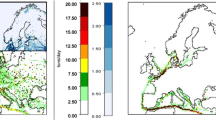Abstract
Air quality model simulations were carried out for the 2010 northern shipping season over a regional Arctic domain. Preliminary evaluation of the base model simulation shows that the model is able to capture the general trends of the observed ambient ozone and PM2.5 in the northern region. Analysis on relative contributions from North American wildfires and Arctic marine/shipping to ambient concentrations of various pollutants and their depositions in the Canadian Arctic and northern regions was conducted.
Access this chapter
Tax calculation will be finalised at checkout
Purchases are for personal use only
Similar content being viewed by others

References
Helmig D et al (2007) The role of ozone atmosphere-snow gas exchange on polar, boundary-layer tropospheric ozone—a review and sensitivity analysis. Atmos Chem Phys 7:15–30. doi:10.5194/acp-7-15-2007
Inness A et al (2013) The MACC reanalysis: an 8 yr data set of atmospheric composition. Atmos Chem Phys 13:4073–4109. doi:10.5194/acp-13-4073-2013
Menard S et al (2014) Current and future developments in numerical air quality forecasting in Canada. In: Steyn DG, Mathur R (eds) Air pollution modelling and its application XXIII. Springer, Dordrecht, pp 629–632
Moran MD et al (2010) Particulate-matter forecasting with GEM-MACH15, a new Canadian air-quality forecast model. In: Steyn DG, Rao ST (eds) Air pollution modelling and its application XX. Springer, Dordrecht, pp 289–292
O’Neill SM et al (2003) The BlueSky smoke modeling framework. In: 5th symposium on fire and forest meteorology. American Meteorological Society, Orlando, FL. www.blueskyrains.org
Acknowledgments
The authors would like to acknowledge The MACC-II project and Xiaobo Yang (ECMWF) for processing the MACC-IFS-MOZART reanalysis data. The support from the EC GEM-MACH development team is much appreciated. We would also like to acknowledge NATChem for providing data from North American air quality monitoring networks.
Author information
Authors and Affiliations
Corresponding author
Editor information
Editors and Affiliations
Question and Answer
Question and Answer
Questioner: Annie Seagram
Q: Other than (perhaps) for political reasons, what is the purpose in the context of this research of comparing the impacts of fire emissions and shipping emissions?
A: We know that the Arctic is often impacted by long-range transport of pollutants, particularly during winter and spring seasons. During summer (also the Arctic shipping season), while the transport from mid-latitudes is reduced due to weaker polar circulation, the North American wildfire emissions are still able to reach the Arctic (as shown in this study). In contrast to the long-range transport which often happens at elevated levels, the emissions from Arctic shipping activities are delivered to the Arctic at levels much closer to the surface. It is important to look at both of these major pollution sources and understand the roles they play in affecting the Arctic air quality and environment.
Rights and permissions
Copyright information
© 2016 Springer International Publishing Switzerland
About this paper
Cite this paper
Gong, W. et al. (2016). Modelling Regional Air Quality in the Canadian Arctic: Impact of North American Wildfire and Arctic Shipping Emissions. In: Steyn, D., Chaumerliac, N. (eds) Air Pollution Modeling and its Application XXIV. Springer Proceedings in Complexity. Springer, Cham. https://doi.org/10.1007/978-3-319-24478-5_49
Download citation
DOI: https://doi.org/10.1007/978-3-319-24478-5_49
Published:
Publisher Name: Springer, Cham
Print ISBN: 978-3-319-24476-1
Online ISBN: 978-3-319-24478-5
eBook Packages: Earth and Environmental ScienceEarth and Environmental Science (R0)



